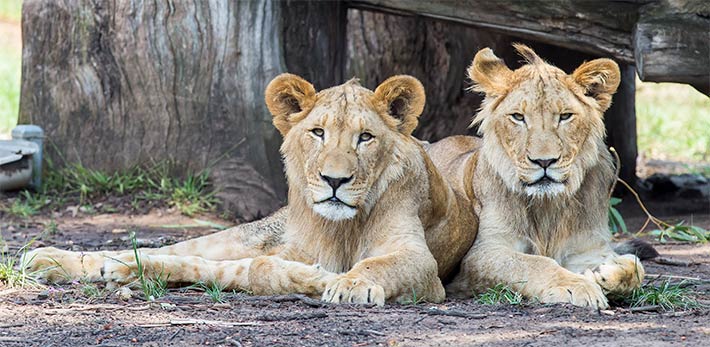Hunter and hunted
A characteristic emblem of African wilderness a century ago lions were 200,000 strong. Present day much of this nations bush is silent of the lion’s roar with numbers plummeting to an estimated 20,000 due to man-made factors such as habitat loss, fragmentation and isolation, illegal wildlife trade and human-wildlife conflict.
Pride of place
African Lions are very social and are the only big cat that regularly lives in family groups called a pride. A pride may include up to three males, a dozen or so females and their young. All of a pride’s lionesses are related. The collective power of the pride is their strength in this balancing act of survival played out daily across the plains of the Maasai Mara.
Cat calls
The second largest of all the big cats, lions have the most complicated communication system of any of their feline relatives. While their roar is significant, they vocalise in many ways including puffs, meows, grunts, growls, gnarls, purrs, hums and moans – every noise with a very specific meaning.
Bound by blood
Each pride has their own story, one that is bound by blood. When the pride male took over these lionesses he killed all cubs and drove away any juvenile males that could be potential threats to his position of power. Hypnotised by the hormonal scent of the lionesses he mates with them sowing his seed of prowess and working in short bursts to put his trademark on the next generation of lions for this pride.
Band of brothers
A lion’s life is a battle of alliances and life as a male cub can be tough. If born as a singleton they can potentially live alone for the rest of their lives, but some join together in groups called bachelor prides. These prides are usually made up of brothers and cousins who have been raised side by side under the protective watch of mothers, aunts and big sisters. The strength of this band of brothers is their blood-bond, sticking together and forming a coalition as they navigate being tested to the limit by nature moving towards their transformation into full maturity.
Life with lions
Humans and lions have shared the same Africa lands for a very long time. Africa is a very special place and lions are one of Africa’s most important animals, however lions are in dangerous decline. Lion populations across Africa face many threats to their continued existence. As development expands, habitat disappears and the normal prey of lions vanishes, human-wildlife conflict is born and extinction is a real possibility for these majestic apex predators.
Sustainability is the world’s greatest innovation challenge and knowledge is one of our most important tools in the fight to save lions. Who better than to guide the protection of these threatened carnivores than the ancient tribes who have been living beside them for centuries.
The Maasai is a proud and independent tribal community in Southern Kenya and northern Tanzania and have an intricate relationship with Africa’s wildlife. Maasai warriors once hunted lions as a rite of passage but now they have turned their spears to protecting them as part of a unique wildlife project. This transformational shift from cultural traditions and beliefs to one of conservation stewardship with tangible benefits for their people is the pinnacle of true behaviour change for a shared future.

Come and meet us
Get to know our lion pride at the The African Savannah at Taronga Zoo Sydney or Lion Pride Lands experience at Taronga Western Plains Zoo Dubbo.